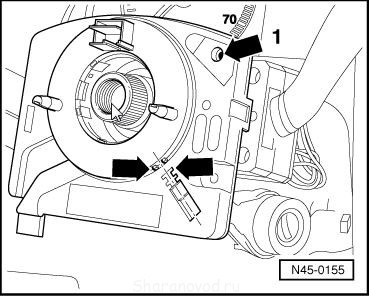
How to replace the steering angle sensor
Content
The steering angle sensor fails if the traction control light comes on, the steering wheel feels loose, or the vehicle moves differently.
When you turn the steering wheel in the desired direction, your vehicle's steerable wheels will turn in that direction. However, the actual procedure is more convoluted, and modern guide structures have proven to be an unimaginably intricate mixture of mechanical parts and equipment. One important segment is the breakpoint sensor.
Two types of sensors are used: analog and digital. Analog gauges rely on different voltage readings as the car turns at different angles. Digital gauges rely on a tiny LED that relays information about the angle the wheel is currently under and sends the information to the car's computer.
The steering wheel angle sensor detects a discrepancy between the course your vehicle is traveling and the position of the steering wheel. The steering angle sensor then balances the steering and gives the driver more control.
The steering angle sensor helps correct the vehicle's position in case of understeer or oversteer. If the vehicle enters an understeer condition, the sensor tells the computer to activate the brake module against the rear wheel inside the steering direction. If the vehicle goes into oversteer, the sensor tells the computer to activate the brake module against the rear wheel out of the direction of steering.
If the steering sensor does not work, the vehicle is unstable and the check engine light comes on. Other common symptoms include a traction control light coming on, a feeling of looseness in the steering wheel, and a change in vehicle movement after the front end is leveled.
Engine light codes related to the steering angle sensor:
C0051, C0052, C0053, C0054, C0053
Part 1 of 3: Steering Angle Sensor Status Check
Step 1. Check if the engine light is on.. If the engine light is on, it could be the steering angle sensor or something else.
Check which codes are indicated if the indicator is on.
Step 2: Get in your car and drive around the block.. Try oversteer and understeer the vehicle and determine if the steering angle sensor is working or not.
If the sensor is working, then the ABS module will attempt to raise or slow down the rear wheels to correct the condition. If the sensor is not working, then the ABS module will not do anything.
Part 2 of 3: Steering Angle Sensor Replacement
Necessary materials
- SAE Hex Wrench Set / Metric
- socket wrenches
- crosshead screwdriver
- Toothpicks
- flat screwdriver
- Protective gloves
- Ratchet with metric and standard sockets
- Safety glasses
- Pliers
- Snap ring pliers
- Steering wheel puller kit
- Torque bit set
- Wheel chocks
Step 1: Park your vehicle on a level, firm surface.. Make sure the transmission is in park (for automatic transmission) or 1st gear (for manual transmission).
Step 2: Install wheel chocks around tires.. In this case, the wheel chocks wrap around the front wheels because the rear of the car will be raised.
Apply the parking brake to block the rear wheels from moving.
Step 3: Open the car hood to disconnect the battery.. Remove the ground cable from the negative battery terminal by turning off power to the steering column and airbag.
- A warning: Do not connect the battery or attempt to power the vehicle for any reason while removing the steering angle sensor. This includes keeping the computer in working order. The airbag will be disabled and may deploy if it is energized.
Step 4: Put on your goggles. Glasses prevent any object from entering the eye.
Step 5: Loosen the fixing screws on the dashboard.. Remove the instrument panel to gain access to the steering wheel base mounting nuts.
Step 6: Remove the mounting nuts located at the rear of the steering column..
Step 7: Remove the horn button from the steering column.. Disconnect the power cord from the horn button.
Make sure you hook the spring under the horn button. Disconnect the yellow power wire from the airbag, making sure you mark the airbag connection.
Step 8: Remove the steering wheel nut or bolt.. You need to keep the steering wheel from moving.
If the nut won't come off, you can use a breaking bar to get the nut off.
Step 9: Purchase a steering wheel puller kit.. Install the steering wheel puller and remove the steering wheel assembly from the steering column.
Step 10: Remove the tilt arm with pliers.. This allows access to the covers on the steering column.
Step 11: Remove plastic steering column covers.. To do this, unscrew 4 to 5 fixing screws on each side.
You can find some hidden mounting screws at the back of the cover near the dashboard trim.
Step 12: Loosen the pin in the pin hole. Turn the key to its original position and use a straight toothpick to release the pin in the pin hole.
Then carefully remove the ignition switch from the steering column.
Step 13: Remove the three plastic clips to remove the clock spring.. Be sure to remove the brackets that may interfere with the removal of the clock spring.
Step 14: Remove the connectors at the bottom of the steering column..
Step 15: Take out the multifunction switch. Disconnect the wiring harness from the switch.
Step 16: Remove the retaining ring. Use circlip pliers and remove the circlip that connects the tilt section to the steering shaft.
Step 17: Use a large flathead screwdriver and pry out the tilt spring.. Be very careful, the spring is under pressure and will jerk out of the steering column.
Step 18: Remove the fixing screws on the ramp section.. You can now prepare the tilt section for removal by removing the mounting screws holding it in place.
Step 19: Remove the nut from the steering shaft bolt on the universal joint.. Remove the bolt and slide the ramp out of the vehicle.
Step 20: Remove the steering angle sensor from the steering shaft.. Disconnect the harness from the sensor.
- Attention: It is recommended to remove and replace the tilt bearing at the rear of the tilt section before reinstallation.
Step 21: Connect the harness to the new steering angle sensor.. Install the sensor on the steering shaft.
Step 22: Install the tilt section back into the vehicle.. Insert the bolt into the cross and install the nut.
Tighten the nut by hand and 1/8 turn.
Step 23: Install the mounting screws securing the tilt section to the steering column..
Step 24: Use a large screwdriver and install the tilt spring.. This part is tricky and the spring is difficult to install.
Step 25: Install the retaining ring on the steering shaft.. Attach the shaft to the inclined section.
Step 26: Set the multifunction switch. Be sure to attach the harness to each part you marked.
Step 27: Install the Connectors on the Bottom of the Steering Column.
Step 28: Insert the clock spring into the steering column.. Install the removed brackets and three plastic clips.
Step 29: Reinstall the key toggle switch in the steering column.. Remove the key and lock the toggle switch in place.
Step 30: Install the plastic covers and secure them with machine screws.. Don't forget the screw that is hidden in the back of the steering column.
Step 31. Install the tilt lever on the steering column..
Step 32: Slide the steering wheel onto the steering shaft. Install the fixing nut and insert the steering wheel into the steering column.
Make sure the nut is tight. Don't overtighten the nut or it will break.
Step 33: Take the horn and airbag assembly.. Connect the yellow airbag wire to the connector marked earlier.
Connect power to the siren. Place the horn spring on the steering column. Attach the horn and airbag to the steering column.
Step 34: Install the mounting bolts to the rear of the steering column.. You may need to click on the tilt section.
Step 35: Install the dashboard back onto the dashboard.. Secure the instrument panel with the fixing screws.
Step 36: Open the car hood. Reconnect the ground cable to the negative battery post.
Step 37: Tighten the battery clamp. Make sure the connection is good.
- AttentionA: Since the power is completely depleted, you will have to reset all your car's settings such as the radio, electric seats, and power mirrors.
Step 38: Remove the wheel chocks.
Part 3 of 3: Test drive the car
Step 1: Insert the key into the ignition.. Start the engine and drive the car around the block.
Step 2: Slowly turn the steering wheel from lock to lock.. This allows the steering angle sensor to calibrate itself without computer programming.
Step 3: Check for an open in the ignition sequence. After a road test, tilt the steering wheel up and down to check if the ignition sequence is out of order.
If your engine does not start after replacing the steering angle sensor, the steering angle sensor may need further diagnostics. If the problem persists, you should seek help from one of AvtoTachki's certified technicians who can check the steering wheel angle sensor circuitry and replace if necessary.
